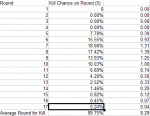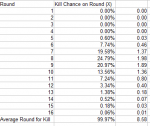Blue
Ravenous Bugblatter Beast of Traal
The calculation I did wasn't calculating overkill damage. It was calculating the rounds to kill an enemy. The point I'm making is that if you kill an enemy faster then any extra time the other build is spending killing the first enemy you are able to redirect whatever damage you can cause in that time to another enemy.
By definition you aren't measuring how overkill slows down your kill rate if you only have a single opponent. Because it ignore that with the two attacks if the first one kills the opponent, the second one can start on the next opponent which leads to quicker killing, while the wasted damage from a single large attack can't. If you want to look at overkill, you need to go to 3+ opponents so you can see the effect.
That said, I think I can adapt the formula I'm using to account for multiple enemies which would be the best way to tackle your question of if the first attack from the 2 attack PC kills an enemy then what happens.
I think I can determine the average number of rounds to kill 5 enemies with 5 hp each. I think that would be sufficient?
Yes - except for the 5 HPs because of the second issue.
Start simple and work toward more complex goals. Variable-Damage is not easy to deal with in a discrete way over multiple rounds. That is a goal I mentioned in my OP.
Eventually we will work our way up to such calcs.
Starting simple in this case is giving us a distorted view of the whole. Think like this - run your numbers with foes of 5 HPs and foes of 4 HPs - they have VERY different results with the 8 dmg & 2x 4 dmg attacks. When fit of the multiple of damage to the foe's HPs is causing such a large variation neither will give a representative result.
In other words, the simple calculations will give misleading results across thresholds where it changes the number of attacks to kill.
Last edited:












